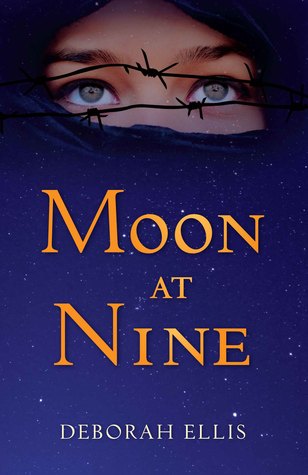Moon at Nine

Earlier this year I was asked to read Moon at Nine, written by Deborah Ellis. Our school inherited a number of copies and my principal thought they might be a good fit in our grade seven human rights literature circle. The book focuses on discrimination faced by two girls who fall in love in Iran. None of the other books in this literature circle focus on gay rights, and I am eager to improve representation by including LGBTQ characters. However, after reading the book and carefully considering it, I'm still not sure what to do with it.

Spoiler Warning
Moon at Nine is based on the life of a real woman interviewed by Deborah Ellis. Like the author's other books, it offers an excellent overview of life for young people in another part of the world. The main character Farrin lives in Iran, under a repressive government. She meets Sadira at her school and the two quickly fall in love. Unfortunately, they are caught and arrested. Sadira is executed and Farrin escapes and goes into exile, only to find her parents have married her off to a much older man.
There are a lot of positive points about this book. It aptly demonstrates life under a repressive regime and how government control creeps into every facet of ordinary people's lives. I also appreciated how Farrin and Sadira's relationship developed over the course of the book. Their love flourished even when everything else in their lives stood against it, which is a powerful message.
However, when the pair were arrested, the plot devolved into a very different story. The girls are beaten, tortured and called deviants. Sadira pays the ultimate price for her identity, but Farrin's fate also made my stomach twist. It was troubling to read how she was rejected by her parents and married off against her will. This ending was dark and left me feeling conflicted.
The events in this book are realistic, and it is a good tool to teach students about the world. They need to understand the importance of human rights and how rights are violated. Indeed, many of the books in the human rights literature circle deal with similarly upsetting content. Characters are murdered by repressive regimes, young people are punished, girls face being married off without their consent. I'd argue that some of the books in our grade six Holocaust literature circle contain even darker content and themes than what is found in Moon at Nine.
However, meaning is ultimately built between the writer and reader. The reader constructs meaning in their own way and it can be hard to say how a story will end up impacting any individual student. How might this story affect a student who is struggling with their own identity? How would it affect a closeted student or one who is not in a safe place, either mentally or physically? Government officials in the book call lesbians deviants and the characters are treated brutally for their relationship. They receive no acceptance from others for their identity. Other than the brief ending where Farrin chooses exile from her new husband, there is very limited resolution. It is a traumatic ending, and I worry about how it could affect students who might have their own internal struggles.
If I know a student is from a war torn country, I would think twice before recommending War Brothers, a book about child soldiers. At the very least I would offer them a trigger warning and be available to discuss heavy topics. It is trickier to do this with Moon at Nine, because it is not always clear which students need that support. I can't know which students are grappling with their own identity, particularly when some students are still coming to terms with these issues.
And so, I am conflicted about this book. I want to protect students who are in dangerous spaces themselves, but I also want my students to be aware of the world. I am straight and I cannot fully understand what my LGBTQ students are going through. It is hard for me to know if I am being oversensitive when considering the heavy topics in this book or not sensitive enough. The easy way out would be to drop the book completely, but I have few books set outside of North America with LGBTQ characters. I'm reluctant to give up a book that could educate so successfully about life in the Middle East for LGBTQ people.
It is still possible to offer this book as part of a literature circle, particularly if I offer trigger warnings and allow students to opt out of the text if they find it traumatic. As well, I would need to balance out this difficult ending with other stories and readings featuring LGBTQ characters, particularly ones that are more hopeful. Currently my human rights literature circle unit is missing these stories and voices. I think it is time for me to revamp the unit and make it more inclusive. I'm still not sure how or if Moon at Nine would fit in the unit, but it has revealed a substantial gap I need to fix.
